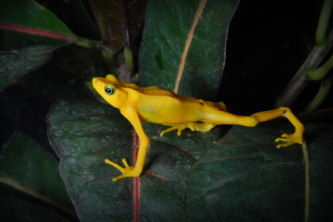Panamanian Golden Frog (Atelopus zeteki)
Welcome to all you could ever want to know about the Panamanian Golden Frog!
 Bryan Johnson
Bryan Johnson
University of Wisconsin - La Crosse
Organismal Biology - BIO 203
Spring 2013
Email: johnson.brya@uwlax.edu
Scientific Name: Atelopus zeteki
Common Name: Panamanian Golden Frog
Right: Courtesy of the Seneca Park Zoo Society.
Photo taken by Wayne Panepinto.
The Panamanian Golden Frog is a fascinating
organism that is exclusive to the tropical forests of Panama.
Facing opposition from the chytrid fungus, Atelopus zeteki
is on the critically endangered list as efforts are being made to
try to sustain its population.

Courtesy of the Dallas Zoological Society.
Photo taken by Cathy Burkey.
Atelopus zeteki is one of multiple species belonging to the genus Atelopus under the domain eukarya. Its classification shares the same domain and kingdom as all other animalia but contains the class amphibia, order anura and family bufonidae which is unique to this organism. As mentioned earlier, the Panamanian Golden Frog's habitat is exclusive to the tropical forests of Panama where it is struggling to survive. One distinguishable adaptation that Atelopus zeteki possesses is its brightly colored yellow skin warning predators of its toxicity. The skin of the frog contains a deadly saxitoxin known as zetekitoxin AB; something nobody wishes to come in contact with. As far as what the Panamanian Golden Frog enjoys for nutrition, its preferences lie with small insects and other small invertebrates that can be found in the native tropical forests of Panama. As the frogs grow, the males' interactions become much more aggressive and other adult males are not welcome in the surrounding area. However, adult females are more than welcome into the territory of the males. If the male and female get along, the male will make the move and reproduce with the female. Eggs are usually released onto rocky substrates in or near the water where the hatched tadpoles have access to the water. This is where they will grow and develop into young frogs. For some fun facts about Atelopus zeteki, visit the facts page or take a look at the gallery for some additional photos. For more about me, click here.
This website is part of a much larger project by the University of Wisconsin - La Crosse. To view more web pages of organisms researched by Organismal Biology and Animal Biology students, please visit www.multipleorganisms.net.
Note: All pictures on this site were properly obtained from their
rightful owners with credit
given.
To view the references page, click here.
